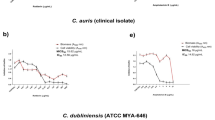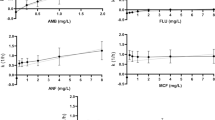Abstract
Cryptococcus neoformans is an opportunistic fungal pathogen that can cause life-threatening invasive fungal infections. As its prevalence and drug resistance continue to rise, cryptococcosis requires new treatment options. Tapping into the potential antifungal effects of traditional drugs or combination therapy has become one of the options. This study was the first to examine the interaction of hydroxychloroquine (HCQ) and itraconazole (ITR) on Cryptococcus neoformans in vitro and in vivo. Our results showed that HCQ alone and in combination with ITR exhibited antifungal activity against C. neoformans planktonic cells. When HCQ was combined with ITR, the minimal inhibitory concentration (MIC) value of HCQ decreased to 32 μg/mL, and the MIC value of ITR decreased from 0.25 μg/mL to 0.06–0.25 μg/mL. The time-killing curve showed that the combined application of HCQ and ITR significantly shortened the killing time, dynamically defining the antifungal activity. The minimum biofilm clearance concentration (MBEC) of HCQ was only 32 μg/mL, which was significantly lower than the MIC of HCQ for planktonic cells. When combined with ITR, the MBEC of ITR decreased from 128 μg/mL to 2–1 μg/mL, and the MBEC of HCQ decreased from 32 μg/mL to 4 μg/mL, indicating a synergistic antifungal biofilm effect. In comparison to ITR alone, the combination of HCQ and ITR treatment increased the survival of C. neoformans–infected Galleria mellonella larvae and decreased the fungal burden of infected larvae. Mechanistic investigations revealed that HCQ might damage C. neoformans cell membranes, impact the structure of fungal cells, cause extracellular material leakage, and have a potent affinity for attaching to the C. neoformans genomic DNA. In conclusion, HCQ has potential clinical application in the treatment of cryptococcosis.






Similar content being viewed by others
Data availability
The datasets used and/or analyzed during the current study are available from the corresponding author on reasonable request.
References
Al-Bari MA (2015) Chloroquine analogues in drug discovery: new directions of uses, mechanisms of actions and toxic manifestations from malaria to multifarious diseases. J Antimicrob Chemother 70:1608–1621. https://doi.org/10.1093/jac/dkv018
Al-Fattani MA, Douglas LJ (2004) Penetration of Candida biofilms by antifungal agents. Antimicrob Agents Chemother 48:3291–3297. https://doi.org/10.1128/AAC.48.9.3291-3297.2004
Alanio A (2020) Dormancy in Cryptococcus neoformans: 60 years of accumulating evidence. J Clin Invest 130:3353–3360. https://doi.org/10.1172/JCI136223
Ashburn TT, Thor KB (2004) Drug repositioning: identifying and developing new uses for existing drugs. Nat Rev Drug Discov 3:673–683. https://doi.org/10.1038/nrd1468
Boelaert JR, Appelberg R, Gomes MS, Blasi E, Mazzolla R, Grosset J et al (2001) Experimental results on chloroquine and aids-related opportunistic infections. J Acquir Immune Defic Syndr 26:300–301. https://doi.org/10.1097/00042560-200103010-00017
Brown GD, Denning DW, Gow NA, Levitz SM, Netea MG, White TC (2012) Hidden killers: human fungal infections. Sci Transl Med 4:165rv13. https://doi.org/10.1126/scitranslmed.3004404
Costerton JW, Stewart PS, Greenberg EP (1999) Bacterial biofilms: a common cause of persistent infections. Science 284:1318–1322. https://doi.org/10.1126/science.284.5418.1318
Geddes-McAlister J, Shapiro RS (2019) New pathogens, new tricks: emerging, drug-resistant fungal pathogens and future prospects for antifungal therapeutics. Ann N Y Acad Sci 1435:57–78. https://doi.org/10.1111/nyas.13739
Ghaffar M, Orr C, Webb G (2019) Antiphagocytic protein 1 increases the susceptibility of Cryptococcus neoformans to amphotericin B and fluconazole. PLoS One 14:e0225701. https://doi.org/10.1371/journal.pone.0225701
Henriet SS, Jans J, Simonetti E, Kwon-Chung KJ, Rijs AJ, Hermans PW et al (2013) Chloroquine modulates the fungal immune response in phagocytic cells from patients with chronic granulomatous disease. J Infect Dis 207:1932–1939. https://doi.org/10.1093/infdis/jit103
Huang Z, Srinivasan S, Zhang J, Chen K, Li Y, Li W et al (2012) Discovering thiamine transporters as targets of chloroquine using a novel functional genomics strategy. PLoS Genet 8:e1003083. https://doi.org/10.1371/journal.pgen.1003083
Jarvis JN, Lawrence DS, Meya DB, Kagimu E, Kasibante J, Mpoza E et al (2022) Single-dose liposomal amphotericin B treatment for cryptococcal meningitis. N Engl J Med 386:1109–1120. https://doi.org/10.1056/NEJMoa2111904
Jiang Y, Dukik K, Muñoz JF, Sigler L, Schwartz IS, Govender NP et al (2018) Phylogeny, ecology and taxonomy of systemic pathogens and their relatives in ajellomycetaceae (onygenales): blastomyces, emergomyces, emmonsia, emmonsiellopsis. Fungal Diversity 90:245–291. https://doi.org/10.1007/s13225-018-0403-y
Jorjao AL, Oliveira LD, Scorzoni L, Figueiredo-Godoi LMA, Cristina APM, Jorge AOC et al (2018) From moths to caterpillars: ideal conditions for Galleria Mellonella rearing for in vivo microbiological Studies. Virulence 9:383–9. https://doi.org/10.1080/21505594.2017.1397871
Kaufmann AM, Krise JP (2007) Lysosomal sequestration of amine-containing drugs: analysis and therapeutic implications. J Pharm Sci 96:729–746. https://doi.org/10.1002/jps.20792
Keshavarzi F (2016) Fungistatic effect of hydroxychloroquine, lessons from a case. Med Mycol Case Rep 13:17–18. https://doi.org/10.1016/j.mmcr.2016.09.003
Kligman AM, Weidman FD (1949) Experimental studies on treatment of human torulosis. Arch Derm Syphilol 60:726–741. https://doi.org/10.1001/archderm.1949.01530050088008
Krezdorn J, Adams S, Coote PJ (2014) A Galleria Mellonella infection model reveals double and triple antibiotic combination therapies with enhanced efficacy versus a multidrug-resistant strain of Pseudomonas aeruginosa. J Med Microbiol 63:945–955. https://doi.org/10.1099/jmm.0.074245-0
Krysan DJ (2017) The unmet clinical need of novel antifungal drugs. Virulence 8:135–137. https://doi.org/10.1080/21505594.2016.1276692
Kumari P, Mishra R, Arora N, Chatrath A, Gangwar R, Roy P et al (2017) Antifungal and anti-biofilm activity of essential oil active components against Cryptococcus neoformans and Cryptococcus laurentii. Front Microbiol 8:2161. https://doi.org/10.3389/fmicb.2017.02161
Levitz SM, Harrison TS, Tabuni A, Liu X (1997) Chloroquine induces human mononuclear phagocytes to inhibit and kill Cryptococcus neoformans by a mechanism independent of iron deprivation. J Clin Invest 100:1640–1646. https://doi.org/10.1172/jci119688
Li L, Sun J, Xia S, Tian X, Cheserek MJ, Le G (2016) Mechanism of antifungal activity of antimicrobial peptide App, a cell-penetrating peptide derivative, against Candida albicans: intracellular DNA binding and cell cycle arrest. Appl Microbiol Biotechnol 100:3245–3253. https://doi.org/10.1007/s00253-015-7265-y
Lu M, Yang X, Yu C, Gong Y, Yuan L, Hao L et al (2018) Linezolid in combination with azoles induced synergistic effects against Candida albicans and protected galleria mellonella against experimental candidiasis. Front Microbiol 9:3142. https://doi.org/10.3389/fmicb.2018.03142
Luo W, Che D, Lu H, Jiang Y (2020) New perspectives from misdiagnosis: a case of primary cutaneous cryptococcosis treated with hydroxychloroquine sulfate successfully. Mycopathologia 185:595–596. https://doi.org/10.1007/s11046-020-00454-9
Martinez LR, Casadevall A (2006) Cryptococcus neoformans cells in biofilms are less susceptible than planktonic cells to antimicrobial molecules produced by the innate immune system. Infect Immun 74:6118–6123. https://doi.org/10.1128/IAI.00995-06
Martinez LR, Fries BC (2010) Fungal biofilms: relevance in the setting of human disease. Curr Fungal Infect Rep 4:266–275. https://doi.org/10.1007/s12281-010-0035-5
Michaud M, Gaches FHydroxychloroquine in systemic lupus erythematosus: comment on the article by muangchan, et al (2016) Arthritis Care Res (hoboken) 68:1052–1053. https://doi.org/10.1002/acr.22780
Narayanan S, Banerjee C, Holt PA (2011) Cryptococcal immune reconstitution syndrome during steroid withdrawal treated with hydroxychloroquine. Int J Infect Dis 15:e70–e73. https://doi.org/10.1016/j.ijid.2010.09.006
Newman SL, Gootee L, Brunner G, Deepe GS Jr (1994) Chloroquine induces human macrophage killing of Histoplasma capsulatum by limiting the availability of intracellular iron and is therapeutic in a murine model of histoplasmosis. J Clin Invest 93:1422–1429. https://doi.org/10.1172/jci117119
Perfect JR (2016) Is there an emerging need for new antifungals? Expert Opin Emerg Drugs 21:129–131. https://doi.org/10.1517/14728214.2016.1155554
Peyclit L, Yousfi H, Rolain JM, Bittar F (2021) Drug repurposing in medical mycology: identification of compounds as potential antifungals to overcome the emergence of multidrug-resistant fungi. Pharmaceuticals (Basel) 14. https://doi.org/10.3390/ph14050488
Pierce CG, Uppuluri P, Tristan AR, Wormley FL, Mowat E, Ramage G et al (2008) A simple and reproducible 96-well plate-based method for the formation of fungal biofilms and its application to antifungal susceptibility testing. Nat Protoc 3:1494–1500. https://doi.org/10.1038/nprot.2008.141
Rossato L, Camargo Dos Santos M, Vitale RG, de Hoog S, Ishida K (2021) Alternative treatment of fungal infections: synergy with non-antifungal agents. Mycoses 64:232–244. https://doi.org/10.1111/myc.13203
Sangalli-Leite F, Scorzoni L, Alves de Paula ESAC, da Silva JF, de Oliveira HC, de Lacorte SJ et al (2016) Synergistic effect of pedalitin and amphotericin B against Cryptococcus neoformans by in vitro and in vivo evaluation. Int J Antimicrob Agents 48:504–511. https://doi.org/10.1016/j.ijantimicag.2016.07.025
Schrezenmeier E, Dorner T (2020) Mechanisms of action of hydroxychloroquine and chloroquine: implications for rheumatology. Nat Rev Rheumatol 16:155–166. https://doi.org/10.1038/s41584-020-0372-x
Shinde RB, Rajput SB, Raut JS, Karuppayil SM (2013) An in vitro repositioning study reveals antifungal potential of chloroquine to inhibit growth and morphogenesis in Candida albicans. J Gen Appl Microbiol 59:167–170. https://doi.org/10.2323/jgam.59.167
Su S, Yan H, Min L, Wang H, Chen X, Shi J et al (2022) The antifungal activity of caspofungin in combination with antifungals or non-antifungals against Candida species in vitro and in clinical therapy. Expert Rev Anti Infect Ther 20:161–178. https://doi.org/10.1080/14787210.2021.1941868
Vesterinen HM, Connick P, Irvine CM, Sena ES, Egan KJ, Carmichael GG et al (2015) Drug repurposing: a systematic approach to evaluate candidate oral neuroprotective interventions for secondary progressive multiple sclerosis. PLoS One 10:e0117705. https://doi.org/10.1371/journal.pone.0117705
Vilcinskas A (2011) Insects emerge as valuable model hosts to explore virulence. Virulence 2:376–8. Epub 2011/10/22. https://doi.org/10.4161/viru.2.5.18289
Weber SM, Levitz SM, Harrison TS (2000) Chloroquine and the fungal phagosome. Curr Opin Microbiol 3:349–53. https://doi.org/10.1016/s1369-5274(00)00102-8
Yang L, Tian Z, Zhou L, Zhu L, Sun C, Huang M et al (2022) In vitro antifungal activity of a novel antimicrobial peptide Amp-17 against planktonic cells and biofilms of Cryptococcus neoformans. Infect Drug Resist 15:233–248. https://doi.org/10.2147/IDR.S344246
Zaragoza O (2019) Basic principles of the virulence of Cryptococcus. Virulence 10:490–501. https://doi.org/10.1080/21505594.2019.1614383
Zuo R, Garrison AT, Basak A, Zhang P, Huigens RW 3rd, Ding Y (2016) In vitro antifungal and antibiofilm activities of halogenated quinoline analogues against Candida albicans and Cryptococcus neoformans. Int J Antimicrob Agents 48:208–211. https://doi.org/10.1016/j.ijantimicag.2016.04.019
Acknowledgements
The authors are grateful to Zhengling Shang of the Department of Immunology, Basic Medical College of Guizhou Medical University, for her help and members of the Department of Dermatology, Affiliated Hospital of Guizhou Medical University for fruitful discussions.
Funding
This work was supported by the district science foundation program (NSFC No. 81960368), from National Natural Science Foundation of China, Science and Technology Planning Project (ZK [2022] General 426), from Guizhou Science and Technology Department, Guizhou Provincial Natural Science Foundation [ZK (2021) zhongdian030],and Guizhou Medical University High-level Talents Start-up Fund (Xiaobo J [2022]013).
Author information
Authors and Affiliations
Contributions
XW carried out the whole experiments and drafted the manuscript. YaJ designed this project, participated in the data analysis, and revised the manuscript. XL and SJ carried out the statistical analysis and participated in the morphologic part of the experiment. JZ and ZZ participated in strain collection and sequencing. SA and YiJ contributed to the discussion and revision of the manuscript. All authors read and approved the manuscript.
Corresponding author
Ethics declarations
Conflict of interest
The authors declare no competing interests.
Additional information
Publisher's Note
Springer Nature remains neutral with regard to jurisdictional claims in published maps and institutional affiliations.
Rights and permissions
Springer Nature or its licensor (e.g. a society or other partner) holds exclusive rights to this article under a publishing agreement with the author(s) or other rightsholder(s); author self-archiving of the accepted manuscript version of this article is solely governed by the terms of such publishing agreement and applicable law.
About this article
Cite this article
Wang, X., Long, X., Jia, S. et al. In vitro and in vivo synergistic effects of hydroxychloroquine and itraconazole on Cryptococcus neoformans. Folia Microbiol 68, 595–605 (2023). https://doi.org/10.1007/s12223-023-01040-4
Received:
Accepted:
Published:
Issue Date:
DOI: https://doi.org/10.1007/s12223-023-01040-4




